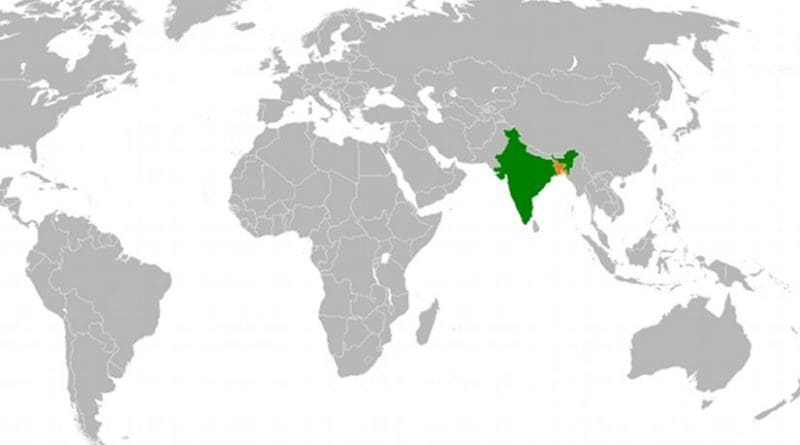India And Bangladesh: The Northeast Thrust – Analysis
By IPCS
By Wasbir Hussain
The Narendra Modi Government appears bent on a new thrust to boost ties with Bangladesh with Northeast India as the key bridgehead from where to launch economic initiatives beneficial to both nations. Sushma Swaraj’s first stand-alone visit as the External Affairs Minister was to Dhaka in June where she primarily sought to remove the trust deficit between the two populous neighbours, and, as a goodwill gesture, offered visa relaxation to children below the age of 13, and citizens above the age of 65. Ground prepared, it was time for her deputy in the Ministry of External Affairs, Gen (Retd) VK Singh, to visit Bangladesh (23-24 August 2014). The point to be noted here is that Gen VK Singh is also the Minister for Development of North Eastern Region or DoNER, and apart from the business delegation he was heading, he was accompanied by government leaders from the Northeast, including the Chief Minister of Meghalaya.
That the Modi Government is keen on consolidating and cementing ties with India’s neighbours is apparent from its decision to improve the quality of relationship with Bangladesh and involving the Northeastern states bordering that country in the endeavour. It was for this reason that Gen Singh chaired a meeting with the Chief Ministers of the Northeastern states in Guwahati just prior to his Dhaka visit. Manik Sarkar, the Chief Minister of Tripura, which shares a 856km long border with Bangladesh, once again voiced the need for transit and trans-shipment facilities including road, rail and waterways connectivity through Bangladesh to the otherwise landlocked Northeast. He urged India’s intervention in persuading Dhaka to allow multi-modal transportation of goods through Bangladesh with Ashuganj as the port of call, including a related infrastructure boost. Tripura’s desire to have the waterways access through Bangladesh, in fact, is a demand voiced by the entire Northeastern region, a vast area of 270,000 square kilometres snapped from the Indian mainland after the country’s partition.
If Delhi or the Northeastern states have their own wish lists, Dhaka too expects India to get a few things done to its satisfaction. For instance, when Gen Singh called on Bangladesh Prime Minister Sheikh Hasina, she stressed the need for India to seal the Teesta Water-Sharing Treaty at the earliest possible. Dhaka is also expecting New Delhi to ratify the Land Boundary Agreement that would allow the two countries to exchange land enclaves. The BJP in Assam, going by the local public mood against transfer of land, has reservations on the ratification of this Agreement. True, the Modi Government enjoys a majority in the Lok Sabha but given the fact that the BJP is hoping to consolidate its position in states like West Bengal, the party is against ignoring local sentiments on a number of issues, including the Teesta deal. Therefore, the attempt at reaching a consensus.
Trade and commerce, besides connectivity, have been the buzzwords during Gen Singh’s Bangladesh visit. He said India wants to further deepen trade ties with Bangladesh. “There is plenty of scope to expand Bangladesh’s trade in India, particularly in the Northeastern region,” Gen Singh said. It is commonly accepted that the economies of both India and Bangladesh can benefit immensely with enhanced bilateral trade and investments. India-Bangladesh trade amounted to a total of NR 31450.51 Crores during 2012-13, which, significantly, was only 0.73 per cent of India’s total trade. The trade, however, is increasing over the years, but the balance of trade is heavily tilted towards India. This situation needs to change. India is now the third largest economy in terms of purchasing power parity (PPP). Bangladesh needs to take advantage of a bigger economy existing side by side. It has to make efforts to tap the large Indian market. The Indian government also needs to overcome challenges in infrastructure, business environment and trade restrictions in order for trade and investment to flow between the two nations.
Bangladesh is slowly becoming an attractive investment destination for Indian companies. Indian investors have further started looking towards investing in Bangladesh after the signing of the Bilateral Investment Protection and Promotion Agreement (BIPPA) between India and Bangladesh in 2009. Both public and private sector companies of India have invested in various projects in Bangladesh. The sectors in which these companies have invested include power, transmission lines, telecom, textiles, chemicals and pharmaceutical, glass, plastics and engineering. Indian investments in Bangladesh stand at US$2.5 billion (till 2012). These investments have created 51,653 jobs in Bangladesh. Till December 2012, 270 direct and joint venture proposals from India had been registered with the Board of Investment, Bangladesh.
Dhaka may have cracked down on Northeast Indian insurgent groups operating out of Bangladesh and facilitated their handover to Indian authorities, but now the two governments need to remove the bottlenecks in trade and connectivity. While India can further improve the export and investment climate for Bangladesh, Dhaka can formalise its decision to let India use its Chittagong and Mongla ports for goods traffic to the Northeast. The need of the hour for both India and Bangladesh is to improve infrastructure along the border and connectivity. Soft power diplomacy can, of course, help improve the man-on-the-street opinion on both sides about each others’ countries.
Wasbir Hussain
Executive Director, Centre for Development & Peace Studies, Guwahati, and Visiting Fellow, IPCS

